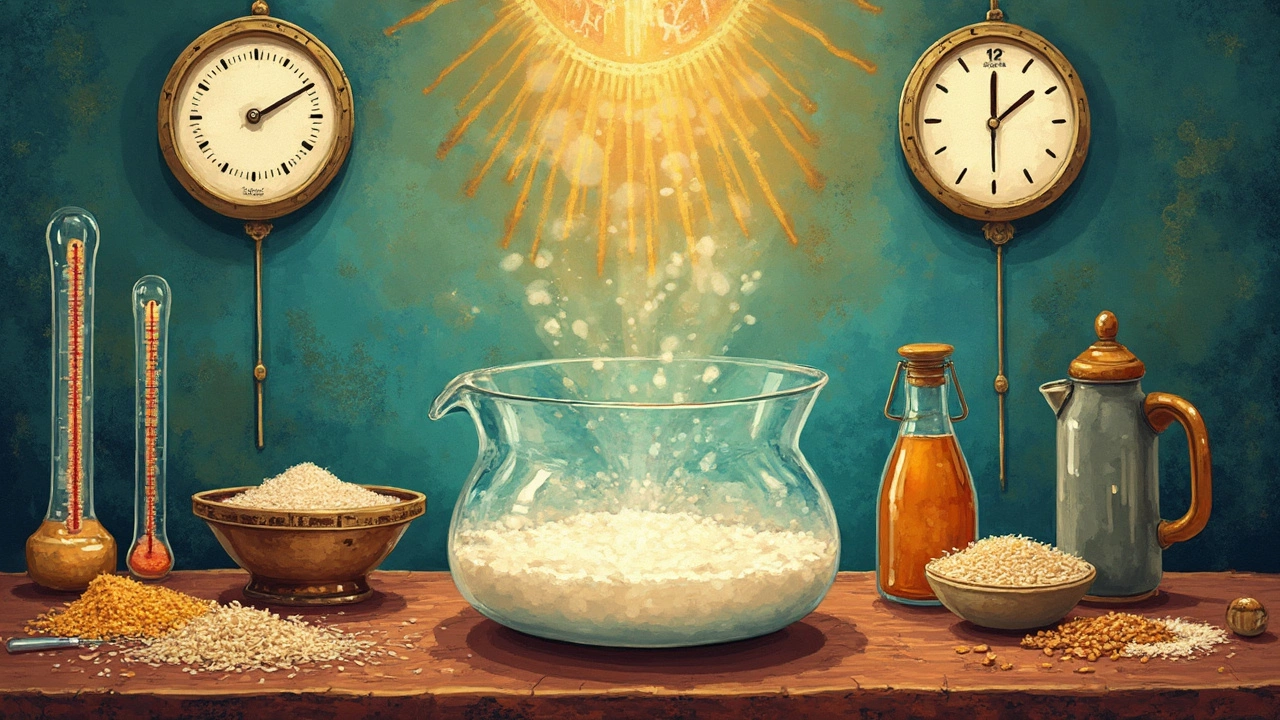Speedy Tips to Ferment Dosa Batter Using Natural Ingredients
 Feb, 18 2025
Feb, 18 2025
Ever tried making dosas, but the batter just doesn’t seem to ferment quickly enough? Well, you’re definitely not alone! Achieving that perfect crispy dosa starts with getting the fermentation right. But how can we speed it up using natural ingredients?
First things first, you want to ensure your batter is mixed just right. The ratio of rice to urad dal is kind of like the secret handshake to a perfect dosa. But it doesn’t stop there. The real game-changer is how you handle it after mixing.
Did you know warm temperatures work like magic for fermentation? Yep, Mumbai's humidity can be your best friend here! If it’s colder, wrap your batter bowl with a cloth or keep it near a warm spot in your kitchen. Adding fenugreek seeds is another traditional trick; they not only boost fermentation but also give that lovely golden color to your dosas.
Stay tuned for more tips on how natural ingredients and a little kitchen wizardry can help you whip up dosas in no time!
- Understanding Dosa Batter Basics
- Natural Ways to Get the Right Fermentation
- Handling Temperature Like a Pro
- Quick Tips for Busy Cooks
Understanding Dosa Batter Basics
So, you want to nail that dosa batter? Well, it all starts with understanding the nuts and bolts of the basics. It’s pretty simple, but a little guidance goes a long way.
The Ingredients
The core ingredients for a typical dosa batter are rice and urad dal (black gram). A good starting ratio is generally 3 cups of rice to 1 cup of urad dal. This combination can be fine-tuned based on personal preferences, but beginners should stick to this for consistent results. Add 1-2 tablespoons of fenugreek seeds for better fermentation and flavor.
Soaking and Grinding
Proper soaking is key—4 to 6 hours should do it. This ensures smooth grinding later. When grinding, it’s crucial to add water gradually. Too much water and the batter won't ferment well; too little and it’ll be too dense. The aim is a smooth, slightly grainy texture.
Mixing It Right
After grinding, combine the rice and dal pastes in a big bowl. Use your hands here; the natural warmth aids fermentation. Mix it well but don't overdo it—just until they are well combined.
| Element | Time | Purpose |
|---|---|---|
| Rice Soaking | 4-6 hours | Softens rice for grinding |
| Urad Dal Soaking | 4-6 hours | Enhances creamy texture |
| Fermentation | 8-12 hours | Creates ideal texture and taste |
Ready for Fermentation
Once mixed, aim for a thick, flowing consistency. It shouldn't be too runny. Cover the bowl loosely; this keeps the warmth in while allowing the batter to rise.
Armed with this foundation, you're set to explore more ways to speed up the fermentation and achieve that perfect dosa!
Natural Ways to Get the Right Fermentation
Alright, so we want that perfect dosa batter. It's not just about waiting and hoping for it to rise. You can give nature a hand, and here's how.
Add Fenugreek Seeds
One tried and true method is adding fenugreek (methi) seeds during soaking. Just a tablespoon or two. Why? They act as natural fermenters and improve the batter’s texture and color. Plus, they add a subtle hint of flavor.
Optimal Soaking
Timing matters! Soak your rice and urad dal separately for at least 4-6 hours and do it in warm water if possible. Warm water absorbs better and gets fermentation off to a running start.
Mix It Well
Once soaked, grind your mixture to a smooth consistency, keeping it slightly thicker than pancake batter. That way, the air works through during fermentation, giving you that lovely rise.
Keep It Warm
In Mumbai, the ambient temperature helps, but on cooler days, try keeping the bowl in the oven with the light on. It creates a warm, cozy spot for your batter to ferment like a boss without extra electricity usage.
Charts & Stats on Fermentation
Believe it or not, humidity and temperature interact with your ingredients. Here's a simple guide:
| Temperature (°C) | Time (hours) | Humidity (% RH) |
|---|---|---|
| 30 | 8-12 | 80-90 |
| 25 | 12-15 | 70-80 |
| 20 | 15-18 | 60-70 |
Armed with these natural tricks, your dosa batter should be all set! It’s all about understanding and leveraging nature’s processes to get the best out of your ingredients without fuss.

Handling Temperature Like a Pro
Temperature is a huge factor when it comes to fermenting dosa batter quickly. In warm weather, you're in luck because it naturally hastens the process. But what if it's a chillier day? No worries! You can still manage a quick fermentation with a few savvy tricks.
Warm It Up
Ever thought about keeping your batter near a light bulb? It might sound odd, but a 60-watt bulb can create just enough warmth. If that’s not an option, try placing the batter inside an oven with just the light on—no heat, just the light!
Wrap It Right
Wrap the container with a clean blanket or a thick cloth, especially if you’re in an air-conditioned room. This retains heat within the batter, giving it the cozy environment it craves.
Temperature Tools
Consider the use of a thermometer if you want to be nerdy about it. Aim for a safe zone of around 28-32°C (82-89°F) for optimal fermentation. It might involve some trial and error at first, but once you nail the process, it's a breeze.
Humidity Helper
If you're facing dry conditions, place a little bowl of water next to the batter or inside that improvised “oven.” Moisture in the air assists with faster fermentation.
Keep these tips in your bag of tricks and watch your dosa batter blossom quicker than ever!
Quick Tips for Busy Cooks
Let’s talk about saving time while ensuring your dosa batter gets its perfect fermentation. Busy days shouldn’t mean compromising on taste, right?
Set It Up Right
Start by soaking your rice and urad dal the night before. Just give it a rinse and let it sit in a bowl. It doesn’t need babysitting - perfect for when you're short on time.
Blending Goodness
When you blend the soaked ingredients, go for the right consistency. Not too thick, not too runny. Imagine pancake batter. This prevents you from having to adjust it later. A well-soaked fenugreek seed blend boosts fermentation.
Strategic Placement
Fermentation thrives on warmth, so set up your batter in a cozy spot. Pop it in your oven with the light on. No need to turn on the heat - the light does the magic.
Just a Pinch of Magic
If you’re really pressed for time, adding a tiny pinch of sugar can help jumpstart the process. It acts as food for the bacteria and yeasts, pushing fermentation.
A Little Helper: Baking Soda
Though not traditional, a pinch of baking soda before cooking can help if your batter isn't quite there yet. It’s your secret hack for those super busy mornings.
Ready to Cook?
When you're ready, heat your pan well. A quick splash of water that sizzles off means you're ready. Remember, a well-heated pan ensures the dosa won’t stick. Time saved and dosas saved, all in one!
A Bit of Stat for the Curious
| Process | Common Time (hours) | Time-Saving Tips (hours) |
|---|---|---|
| Soaking | 8 | Overnight soaking |
| Fermentation | 12 | 6-8 with warmth |
Using these simple yet effective strategies, your other chores won’t suffer, and you’ll still have that crispy dosa ready to impress. Who said you can’t have it all?